How to make a Scotch egg (and see below for instructions for a Bloody Mary)
Based on our local, seasonal, and vegetable-heavy eating habits, many people assume that Lindsay and I are vegetarians (or vegans!). This post provides evidence to the contrary. Yesterday, we made brunch by frying up eggs, each wrapped in a quarter-pound of sausage. We also managed to do it all with local ingredients. Mmmm!
We based the recipe on a recent post in the NY Times, but were really inspired by a nearby restaurant, The Breslin, which serves excellent Scotch eggs. If you want extremely delicious but extremely heavy fare, try out that restaurant! We made 4 Scotch eggs and 2 Bloody Marys, which would cost around $55 after tax and tip. We did it all for under $20.
$20 still sounds expensive, but most of that comes from the sausage. We eat a lot less meat than most people, but when we do we are sure to choose meat that is local, naturally fed, and full-pasture. It’s far more expensive (one of the reasons we eat less of it), but the health and nutrition profile is very different from industrial meat. Cows that eat nothing but corn cause humans cardiovascular problems. Cows raised completely on natural pasture have a profile similar to wild salmon (without the Mercury). For more information, read Michael Pollan.
We got the sausage from Grazin’ Angus Acres (sweet Italian sausage), which, as far as I’m concerned, sells the best beef money can buy.
Also notice how vibrant the yolks in the eggs are compared to the greenish-yellow hue that hard boiled eggs normally have. That’s the difference of naturally-raised and fully pastured chickens.
Ingredients:
| Amount | Ingredient | Preparation | Where we bought it (* Union Square Greenmarket) |
|---|---|---|---|
| 6 | Large eggs | Northshire Farm * | |
| 2 cloves | Garlic | Minced | Keith’s Farm * |
| Pinch | Kosher salt | ||
| 1 – 2 | Whole pieces, horseradish | Grated | Gorzynski Ornery Farm * |
| Splash | White vinegar | ||
| 1 lb | Italian sausage | Casing removed | Grazin’ Angus Acres * |
| 1/4 cup | All-purpose flour | Cayuga Pure Organics * | |
| 1/4 cup | Panko bread crumbs | Whole Foods | |
| ~ 8 oz | Sunflower oil (or other frying oil) | Stolor Organics (sold by Cayuga Organics)* |
Directions:
- Place 4 of the eggs in a medium pot or saucepan and add cold water until they are submerged. Cover with a lid and bring the water to a boil over hight heat. Turn off the heat and leave covered for 3 minutes. Uncover the pot and let it sit for 10 minutes.
- Peel each egg under running cold water and pat dry.
- Mince the garlic. Use a mortar and pestle (or the back of a spoon, or a knife) to mash the garlic and the pinch of salt into a paste.
- Peel the horseradish and cut it into manageable pieces. Use a microplane or grater to grate the horseradish as finely as possible. Add a splash of white vinegar to mix the horseradish into a paste similar to prepared horseradish that you can buy in a jar. You are aiming for about 2 tablespoons Alternately, you can skip this step and use 2 tablespoons of prepared horseradish from a jar. But grating it fresh will give you a head start on your Bloody Marys (see below).
- Remove the casing from the sausages. If you can find ground sausage without casings, you can skip this step.
Begin by cutting off the end of the casing with a meat scissor. Then work the scissor lengthwise into the casing.
Cut the casing along the length of the sausage. Now, you should be able to peel of the casing in one piece.
- Place all of the de-cased sausage into a bowl. Add the garlic paste and horseradish paste and mix thoroughly by hand. Divide the sausage into 4 equal portions.
- Prepare an assembly line of four bowls. The first bowl should contain the flour. The second should be the bowl with the sausage in it. In the third bowl, lightly beat the 2 remaining eggs. The fourth bowl should contain the Panko bread crumbs.
- Repeat the remaining steps for each egg.
Roll the egg in the flour. Flatten a 1/4 portion of the sausage into a patty.
Wrap the egg in it and form it into an even ball around the egg. Dredge the sausage-coated egg in the flour.
Shake off the excess flour, then dip it in the beaten eggs. Let the excess drip off. Roll the ball in the Panko to cover it thoroughly.
- Fill a medium pot with oil to 1/2 inch depth and turn the burner on to medium. Heat until it reaches 350 degrees, or if you don’t have a thermometer that you can use for frying (we don’t), until the oil starts to shimmer and bubbles form around the edges of the pot.
The smaller the pot you use, the less oil you will need. We used a small saucepan, but it meant that we could only fry one egg at a time. The advantage to this, though, is that the first egg is almost guaranteed to come out worse than the rest. The first egg will both get the oil going, and allow you to adjust the temperature. If you fry two eggs at a time, you will have two “first eggs”.
- Turn the heat down to medium-low. Use a wooden or metal spoon, preferably slotted, lower the first egg into the oil. Do it very slowly and carefully, so as not to splash the hot oil. Set a timer for two minutes. Give the oil a moment to react to the egg. It should sizzle but not go crazy. If it begins to sizzle and pop too energetically, turn the heat down further.
- After the two minutes, use the spoon or tongs to roll the egg over 180 degrees to fry the exposed half.
- After another two minutes, roll the egg to check for any under-fried spots and roll until those are face-down in the oil. After another two minutes, check to make sure that the entire egg is evenly fried. If it is, let it sit for another minute or two while rolling it to evenly re-fry the whole surface. This will also make sure that the sausage it thoroughly cooked through. In total, the frying should take 7 – 8 minutes.
- Place a cooling rack inside of a sheet pan. Turn the oven on to 250 degrees. Use the spoon or tongs to remove the egg from the oil and place it on the rack. Sprinkle with Kosher salt. Put the rack into the oven to keep the egg warm while cooking the rest of the eggs.
Alternately, to serve immediately after frying you can place the egg onto a plate lined with paper towels and give it a moment to wick away the excess oil.
Notice the one burnt egg in the picture below. That was our first one, the “sacrifice”. It was still excellent.
- To eat, cut the Scotch egg in half and enjoy. Just for the record, we only had one each for brunch and stored the other two for leftovers. It was a close call, though. I had really had to exercise will power!
The Bloody Marys
To supplement the Scotch eggs we made some Bloody Marys which were also prettylocal, thanks to Lindsay’s frantic canning of various tomato products in August / September. One of the things she canned from local tomatoes was Bloody Mary mix. We will be sure to post the recipe and the process next year when canning season rolls around again.
We used 10 oz of the mix per glass, and added:
- 1 oz of vodka
- 5-10 drops of Worcestershire sauce
- 5-10 drops of Tabasco
- A generous pinch of salt
- A healthy grind of fresh pepper
- 1 teaspoon of freshly grated horseradish, which I grated while making the Scotch eggs
Stir well and sip happily.

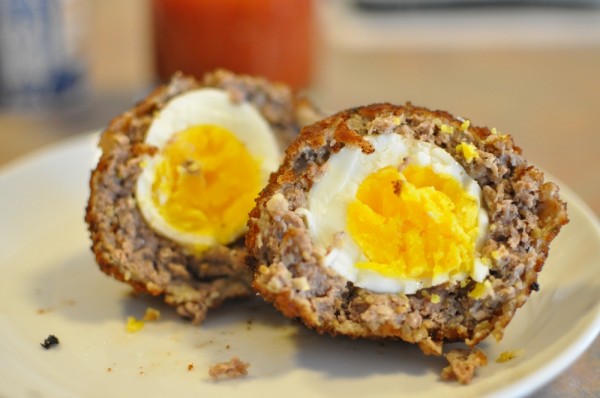
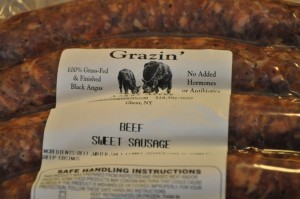
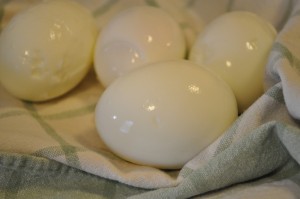
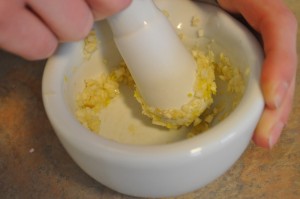
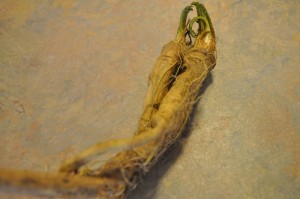
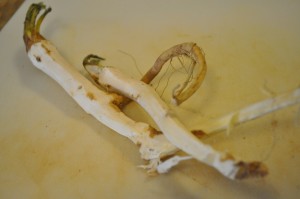
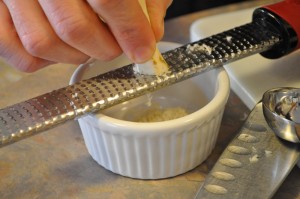
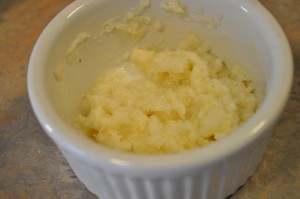
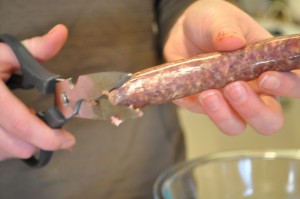
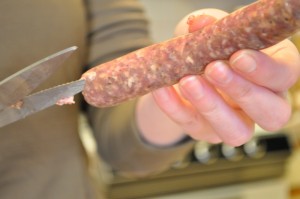


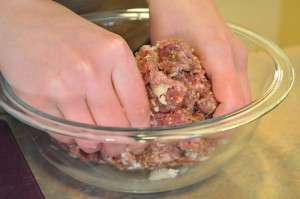
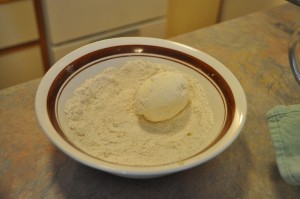
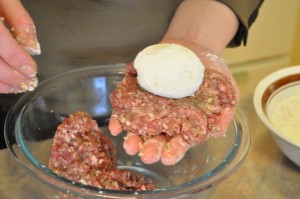
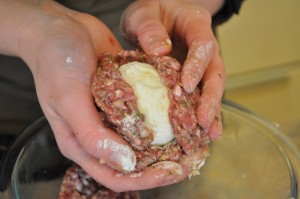
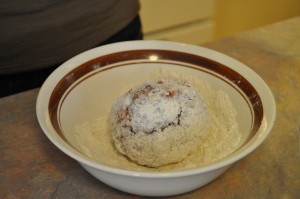
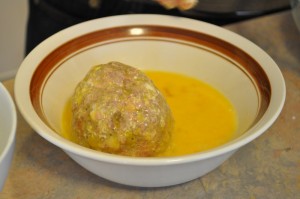
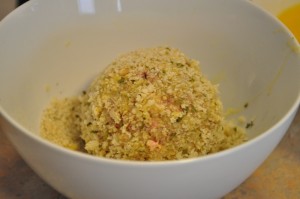
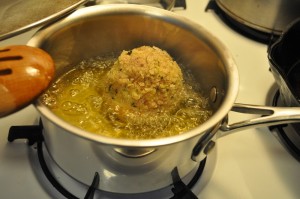
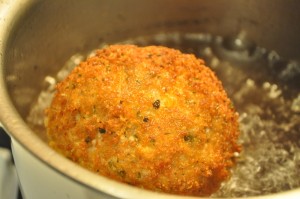
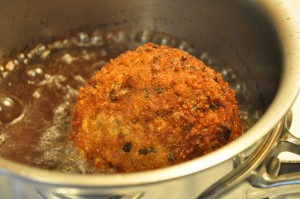

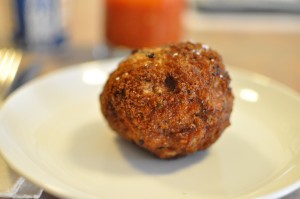
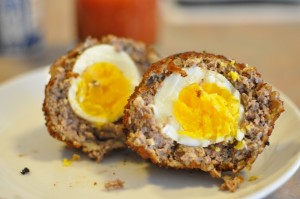

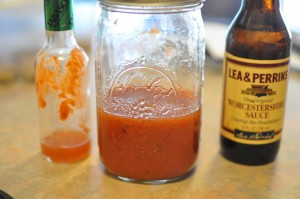
Please post the recipe for canning bloody mary mix. It’s something I want to do this summer.
[...] post is further proof that “we are not vegetarians“. We have purchased and cooked more meat in the past ten days than in the prior three months, [...]